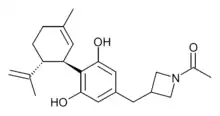KLS-13019
 | |
| Identifiers | |
|---|---|
IUPAC name
| |
| CAS Number | |
| PubChem CID | |
| Chemical and physical data | |
| Formula | C22H29NO3 |
| Molar mass | 355.478 g·mol−1 |
| 3D model (JSmol) | |
SMILES
| |
InChI
| |
KLS-13019 is a cannabidiol derivative that has been modified on the side chain to improve solubility and tissue penetration properties. It was developed and patented by Neuropathix subsidiary Kannalife and found to be 50x more potent than cannabidiol as a neuroprotective agent, thought to be mediated by modulation of the sodium-calcium exchanger channel. It also had a higher therapeutic index than cannabidiol.[1][2][3] Both KLS-13019 and cannabidiol, prevented the development of CIPN, while only KLS-13019 uniquely reversed neuropathic pain from chemotherapy. KLS-13019 binds to fewer biological targets than cannabidiol and KLS-13019 may possess the unique ability to reverse addictive behaviour, an effect not observed with cannabidiol.[4]
See also
References
- ↑ Kinney WA, McDonnell ME, Zhong HM, Liu C, Yang L, Ling W, et al. (April 2016). "Discovery of KLS-13019, a Cannabidiol-Derived Neuroprotective Agent, with Improved Potency, Safety, and Permeability". ACS Medicinal Chemistry Letters. 7 (4): 424–8. doi:10.1021/acsmedchemlett.6b00009. PMC 4834656. PMID 27096053.
- ↑ Brenneman DE, Petkanas D, Kinney WA (September 2018). "Pharmacological Comparisons Between Cannabidiol and KLS-13019". Journal of Molecular Neuroscience. 66 (1): 121–134. doi:10.1007/s12031-018-1154-7. PMC 6150782. PMID 30109468.
- ↑ Brenneman DE, Kinney WA, Ward SJ (August 2019). "Knockdown siRNA Targeting the Mitochondrial Sodium-Calcium Exchanger-1 Inhibits the Protective Effects of Two Cannabinoids Against Acute Paclitaxel Toxicity". Journal of Molecular Neuroscience. 68 (4): 603–619. doi:10.1007/s12031-019-01321-z. PMC 6615992. PMID 31077084.
- ↑ Foss JD, Farkas DJ, Huynh LM, Kinney WA, Brenneman DE, Ward SJ (April 2021). "Behavioral and pharmacological effects of cannabidiol (CBD) and the CBD analogue KLS‐13019 in mouse models of pain and reinforcement". British Journal of Pharmacology. doi:10.1111/bph.15486. PMID 33822373.
This article is issued from Offline. The text is licensed under Creative Commons - Attribution - Sharealike. Additional terms may apply for the media files.